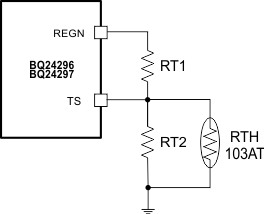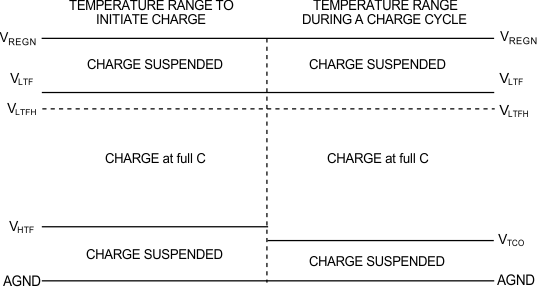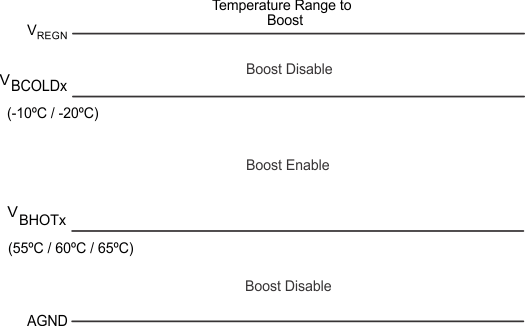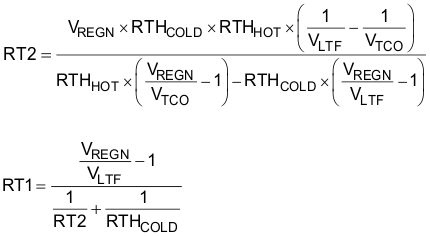JAJSJW8D september 2013 – april 2023 BQ24296 , BQ24297
PRODUCTION DATA
- 1 特長
- 2 アプリケーション
- 3 概要
- 4 Revision History
- 5 Description (continued)
- 6 Device Comparison Table
- 7 Pin Configuration and Functions
- 8 Specifications
-
9 Detailed Description
- 9.1 Overview
- 9.2 Functional Block Diagram
- 9.3
Feature Description
- 9.3.1 Device Power Up
- 9.3.2 Power Path Management
- 9.3.3 Battery Charging Management
- 9.3.4 Status Outputs ( PG, STAT, and INT)
- 9.3.5 Protections
- 9.4 Device Functional Modes
- 9.5 Programming
- 9.6
Register Map
- 9.6.1
I2C Registers
- 9.6.1.1 Input Source Control Register REG00 [reset = 00110xxx, or 3x]
- 9.6.1.2 Power-On Configuration Register REG01 [reset = 00011011, or 0x1B]
- 9.6.1.3 Charge Current Control Register REG02 [reset = 01100000, or 60]
- 9.6.1.4 Pre-Charge/Termination Current Control Register REG03 [reset = 00010001, or 0x11]
- 9.6.1.5 Charge Voltage Control Register REG04 [reset = 10110010, or 0xB2]
- 9.6.1.6 Charge Termination/Timer Control Register REG05 [reset = 10011010, or 0x9A]
- 9.6.1.7 Boost Voltage/Thermal Regulation Control Register REG06 [reset = 01110011, or 0x73]
- 9.6.1.8 Misc Operation Control Register REG07 [reset = 01001011, or 4B]
- 9.6.1.9 System Status Register REG08
- 9.6.1.10 New Fault Register REG09
- 9.6.1.11 Vender / Part / Revision Status Register REG0A
- 9.6.1
I2C Registers
- 10Application and Implementation
- 11Power Supply Recommendations
- 12Layout
- 13Device and Documentation Support
- 14Mechanical, Packaging, and Orderable Information
パッケージ・オプション
メカニカル・データ(パッケージ|ピン)
- RGE|24
サーマルパッド・メカニカル・データ
- RGE|24
発注情報
9.3.3.3.1 Cold/Hot Temperature Window
The device continuously monitors battery temperature by measuring the voltage between the TS pin and ground, typically determined by a negative temperature coefficient thermistor and an external voltage divider. The device compares this voltage against its internal thresholds to determine if charge or boost is allowed.
To initiate a charge cycle, the battery temperature must be within the VLTF to VHTF thresholds. During the charge cycle the battery temperature must be within the VLTF to VTCO thresholds, else the device suspends charging and waits until the battery temperature is within the VLTF to VHTF range.
For battery protection during boost mode, the device monitors the battery temperature to be within the VBCOLDx to VBHOTx thresholds unless boost mode temperature is disabled by setting BHOT bits (REG06[3:2]) to 11. When temperature is outside of the temperature thresholds, the boost mode is suspended and REG08[7:6] bits (VBUS_STAT) are set to 00. Once temperature returns within thresholds, the boost mode is recovered.
 Figure 9-7 TS
Resistor Network
Figure 9-7 TS
Resistor NetworkWhen the TS fault occurs, the fault register REG09[2:0] indicates the actual condition on each TS pin and an INT is asserted to the host. The STAT pin indicates the fault when charging is suspended.
 Figure 9-8 TS Pin
Thermistor Sense Thresholds in Charge Mode
Figure 9-8 TS Pin
Thermistor Sense Thresholds in Charge Mode Figure 9-9 TS Pin
Thermistor Sense Thresholds in Boost Mode
Figure 9-9 TS Pin
Thermistor Sense Thresholds in Boost ModeAssuming a 103AT NTC thermistor is used on the battery pack Figure 9-8, the value RT1 and RT2 can be determined by using the following equation:

Select 0°C to
45°C range for Li-ion or Li-polymer battery,
RTHCOLD = 27.28 kΩ
RTHHOT =
4.911 kΩ
RT1 = 5.25 kΩ
RT2 = 31.23 kΩ